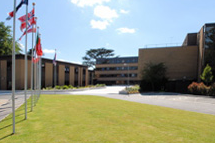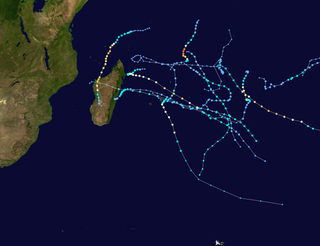
The European Centre for Medium-Range Weather Forecasts (ECMWF) is an independent intergovernmental organisation supported by most of the nations of Europe. It is based at three sites: Shinfield Park, Reading, United Kingdom; Bologna, Italy; and Bonn, Germany. It operates one of the largest supercomputer complexes in Europe and the world's largest archive of numerical weather prediction data.

Machine translation is use of computational techniques to translate text or speech from one language to another, including the contextual, idiomatic and pragmatic nuances of both languages.
Prolog is a logic programming language that has its origins in artificial intelligence, automated theorem proving and computational linguistics.
Planner is a programming language designed by Carl Hewitt at MIT, and first published in 1969. First, subsets such as Micro-Planner and Pico-Planner were implemented, and then essentially the whole language was implemented as Popler by Julian Davies at the University of Edinburgh in the POP-2 programming language. Derivations such as QA4, Conniver, QLISP and Ether were important tools in artificial intelligence research in the 1970s, which influenced commercial developments such as Knowledge Engineering Environment (KEE) and Automated Reasoning Tool (ART).
Eurotra was a machine translation project established and funded by the European Commission from 1978 until 1992.

Alain Colmerauer was a French computer scientist. He was a professor at Aix-Marseille University, and the creator of the logic programming language Prolog.
TAUM is the name of a research group which was set up at the Université de Montréal in 1965. Most of its research was done between 1968 and 1980.
Computer-aided translation (CAT), also referred to as computer-assisted translation or computer-aided human translation (CAHT), is the use of software, also known as a translator, to assist a human translator in the translation process. The translation is created by a human, and certain aspects of the process are facilitated by software; this is in contrast with machine translation (MT), in which the translation is created by a computer, optionally with some human intervention.

MétéoMédia is a Canadian French-language weather information specialty channel and web site owned by Pelmorex. MétéoMédia primarily serves viewers in Quebec, although some cable TV systems in Ontario and New Brunswick carry the channel as well. It is available nationwide via satellite. MétéoMédia went on the air along with the bilingual specialty service's English-language component, The Weather Network, for the first time on September 1, 1988; both MétéoMédia and The Weather Network broadcast separate 24-hour-a-day feeds.
HIRLAM, the High Resolution Limited Area Model, is a Numerical Weather Prediction (NWP) forecast system developed by the international HIRLAM programme.
A definite clause grammar (DCG) is a way of expressing grammar, either for natural or formal languages, in a logic programming language such as Prolog. It is closely related to the concept of attribute grammars / affix grammars. DCGs are usually associated with Prolog, but similar languages such as Mercury also include DCGs. They are called definite clause grammars because they represent a grammar as a set of definite clauses in first-order logic.
Q-systems are a method of directed graph transformations according to given grammar rules, developed at the Université de Montréal by Alain Colmerauer in 1967–70 for use in natural language processing. The Université de Montréal's machine translation system, TAUM-73, used the Q-Systems as its language formalism.
Machine translation is a sub-field of computational linguistics that investigates the use of software to translate text or speech from one natural language to another.

Microsoft Translator or Bing Translator is a multilingual machine translation cloud service provided by Microsoft. Microsoft Translator is a part of Microsoft Cognitive Services and integrated across multiple consumer, developer, and enterprise products, including Bing, Microsoft Office, SharePoint, Microsoft Edge, Microsoft Lync, Yammer, Skype Translator, Visual Studio, and Microsoft Translator apps for Windows, Windows Phone, iPhone and Apple Watch, and Android phone and Android Wear.

Nowcasting is weather forecasting on a very short term mesoscale period of up to 2 hours, according to the World Meteorological Organization, and up to six hours, according to other authors in the field. This forecast is an extrapolation in time of known weather parameters, including those obtained by means of remote sensing, using techniques that take into account a possible evolution of the air mass. This type of forecast therefore includes details that cannot be solved by numerical weather prediction (NWP) models running over longer forecast periods.
memoQ is a proprietary computer-assisted translation software suite which runs on Microsoft Windows operating systems. It is developed by the Hungarian software company memoQ Fordítástechnológiai Zrt., formerly Kilgray, a provider of translation management software established in 2004 and cited as one of the fastest-growing companies in the translation technology sector in 2012, and 2013. memoQ provides translation memory, terminology, machine translation integration and reference information management in desktop, client/server and web application environments.
Brian Harris is a Canadian and British translation researcher.

The 2016–17 South-West Indian Ocean cyclone season was a below-average season, with five tropical storms, three of which intensified into tropical cyclones. It officially began on November 15, 2016, and ended on April 30, 2017, with the exception for Mauritius and the Seychelles, for which it ended on May 15, 2017. These dates conventionally delimit the period of each year when most tropical and subtropical cyclones form in the basin, which is west of 90°E and south of the Equator. Tropical and subtropical cyclones in this basin were monitored by the Regional Specialised Meteorological Centre in Réunion, though the Joint Typhoon Warning Center issued unofficial advisories.

The 2019–20 South-West Indian Ocean cyclone season was a slightly above-average season in tropical cyclone and subtropical cyclone formation west of 90°E. The season officially began on 15 November, however, the formation of the first system—Zone of Disturbed Weather 01—occurred on 22 July 2019, well before the official start of the season. This was the earliest start to a season since the 2016–17 season. The season then officially ended on 30 April 2020, with the exception of Mauritius and the Seychelles, for which it officially ended on 15 May 2020. These dates conventionally delimit the period of each year when most tropical and subtropical cyclones form in the basin, which is west of 90°E and south of the Equator. Tropical and subtropical cyclones in this basin are monitored by the Regional Specialized Meteorological Centre in Réunion.

The 2020–21 South-West Indian Ocean cyclone season was an above-average season which produced 12 named storms, with 7 strengthening into tropical cyclones. The season started with the formation of Cyclone Alicia in the extreme northeast section of the basin on 12 November 2020, just before the official start of the season, which marked the third season in a row in which a tropical cyclone formed before the official start of the season. It officially began on 15 November 2020, and ended with the dissipation of Cyclone Jobo on 24 April, 6 days before the official end on 30 April 2021, with the exception of Mauritius and the Seychelles, which officially ended on 15 May 2021. These dates conventionally delimit the period of each year when most tropical and subtropical cyclones form in the basin, which is west of 90°E and south of the Equator. Tropical and subtropical cyclones in this basin are monitored by the Regional Specialised Meteorological Centre in Réunion and unofficially by the Joint Typhoon Warning Center.








